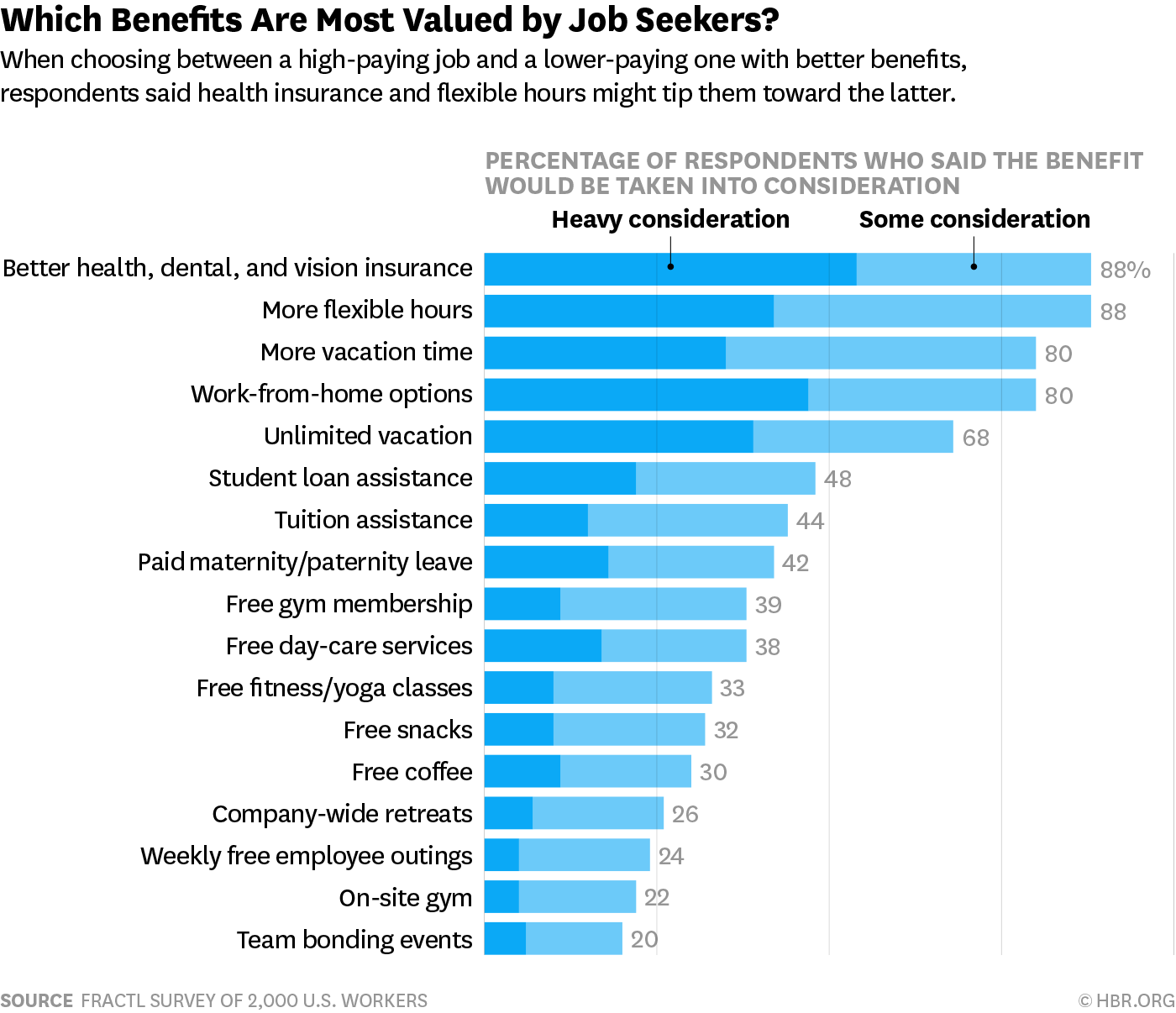How to Choose the Right Employee Benefits for Recruiting Top Talent

Employee benefits are an important part of any workplace. They can help to attract new employees, keep current employees happy, and improve the overall productivity of a company. But with so many different types of benefits available, it can be difficult to know which ones are right for your business.
This article will outline some of the most common employee benefits and discuss the pros and cons of each one. By understanding the options available to them, employers can make more informed decisions about what benefits to offer their workers.
What are employee benefits and why are they important?
Employee benefits are any type of benefit that employees receive as part of their job. This could include anything from health insurance to 401k plans to flexible work schedules.

Source: HBR
Benefits are important for several reasons. First, they can help to attract new employees by providing additional incentives beyond just a salary. Second, they can help to keep current employees happy by giving them added perks and flexibility. And third, they can improve the overall productivity of a company by helping employees focus on their work instead of their personal finances.
The most common types of employee benefits
There are many different types of employee benefits available, but some are more common than others. The most common types of benefits include:
Health insurance
This is probably the most common type of benefit offered by companies. It helps employees pay for medical expenses and can be a valuable asset in case of an unexpected illness or injury.
Retirement savings
401k plans and other retirement savings plans are popular among employees because they allow them to save for their future while still having access to their money if needed.
Flexible work schedules
A growing number of companies are offering flexible work schedules (or even a four day work week) as a way to appeal to new employees and keep current ones happy. This allows employees to work when they are most productive instead of having to stick to a traditional 9-5 schedule.
Paid time off
Paid time off (PTO) is another popular benefit that allows employees to take time off for vacation, sick days, or personal days without having to use up their vacation days.
Child care assistance
Many companies now offer child care assistance as a way to help working parents manage their family responsibilities while also maintaining their jobs.
Tuition reimbursement
Tuition reimbursement is another growing trend among companies and is designed
Pros and cons of each type of benefit
Health Insurance
Pros: Health insurance is a valuable asset for employees, as it helps them pay for medical expenses. It can also be a lifesaver in case of an unexpected illness or injury.
Cons: Health insurance can be expensive, and it can be difficult to find a plan that fits the needs of your employees.
Retirement Savings
Pros: 401k plans and other retirement savings plans are popular among employees because they allow them to save for their future while still having access to their money if needed.
Cons: Employers may not match employee contributions, which can make it difficult for employees to save for retirement.
Flexible Work Schedules
Pros: A growing number of companies are offering flexible work schedules as a way to appeal to new employees and keep current ones happy. This allows employees to work when they are most productive instead of having to stick to a traditional 9-5 schedule.
Cons: Flexible work schedules can be difficult to manage if employees are not disciplined enough to stay on task without a boss looking over their shoulder.
Paid Time Off
Pros: Paid time off (PTO) is another popular benefit that allows employees to take time off for vacation, sick days, or personal days without having to use up their vacation days.
Cons: Some employers do not offer paid holidays, which can be a disadvantage for employees who want to take time off for religious reasons or national holidays.
Child Care Assistance
Pros: Many companies now offer child care assistance as a way to help working parents manage their family responsibilities while also maintaining their jobs.
Cons: Child care assistance can be expensive and may not cover the full cost of child care.
How to choose the right employee benefits for your business
When it comes to employee benefits, there are a lot of different options to choose from. So how do you know which ones are right for your business? Here are a few tips:
- Look at your budget: It’s important to find benefits that fit within your budget. You don’t want to offer benefits that you can’t afford and end up struggling financially.
- Consider your employees’ needs: When choosing benefits, think about what your employees need and want. offering benefits that meet their needs will make them happier and more productive in the workplace.
- Research different options: There are many different types of employee benefits, so it’s important to do your research and find the ones that are best suited for your business.
- Talk to an expert: If you’re not sure what type of benefits to offer, talk to an expert who can help you make the right decision.
Offering the right employee benefits can be a great way to attract new employees and keep current ones happy. By taking the time to choose the right benefits, you can create a happy and productive workforce that is focused on achieving your business goals.
Get the Right Employee Benefits to Attract & Retain Top Talent
Employee benefits are an important part of any company, and choosing the right benefits when you’re staffing for and recruiting employees can be tricky. Here are a few tips to help you make the right decision:
- Look at your budget and find benefits that fit within your financial constraints
- Consider what your employees need and want in order to choose benefits that will be appealing to them
- Do your research and find the best options for your business
- Talk to an expert if you’re not sure what type of benefits to offer
Choosing the right employee benefits can be a daunting task, but it’s important to do your research and find the ones that are best suited for your business.
By offering employees benefits that meet their needs, you can create a happy and productive workforce that is focused on achieving your business goals.
- Mastering Internal Mobility: A Comprehensive Guide to Success - August 10, 2023
- Effective Recruiting Strategies in a Competitive Sales Labor Market - July 27, 2023
- 6 Essential Factors to Attract Top Talent - July 19, 2023
